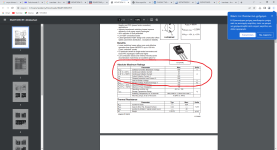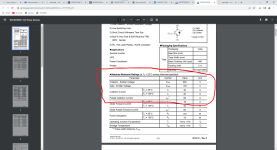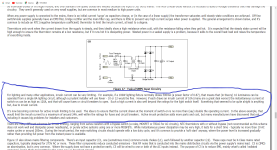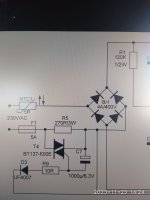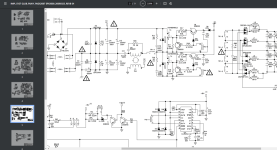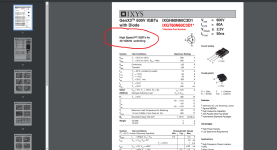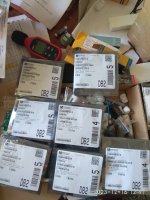IR2153D is the same as IR2153, the only difference is in the internal bootstrap diode (IR2153D). It doesn't matter if you use IR2153D also install external diode.
Ok,thanks!
I want to menson here that IR2153 that i used are from a local supplier as this isn't available in Mouser.
I hope that there aren't fake IR2153.
Looking at the IGBT specs,i see big differance in this area.
Pulced collector current. Icm=220A for the IRG4PC50W
Pulced collector current. Icp=60A for RGT40TS65DGC11
I don't know if this is something important.
I want to menson here that IR2153 that i used are from a local supplier as this isn't available in Mouser.
I hope that there aren't fake IR2153.
Looking at the IGBT specs,i see big differance in this area.
Pulced collector current. Icm=220A for the IRG4PC50W
Pulced collector current. Icp=60A for RGT40TS65DGC11
I don't know if this is something important.
Attachments
Last edited:
I asked this because i read by Eliot here.https://sound-au.com/articles/smps-primer.html
Attachments
Last edited:
sorry I don't know for sure if the designer chose irg4pc50w because of this parameter and because ir2153 doesn't have softstart
all suggested by digikey as substitution for IRG4PC50W have lower pulsed drain current

I found this 300A pulsed current used by behringer : IXGH60N60C3D1
220A Icm : STGW40NC60KD, crown uses STGY40NC60VD
I checked behringer sps1000 and yamaha emx5000 (IR2153) use 1MBK50D (150A Icp)
all suggested by digikey as substitution for IRG4PC50W have lower pulsed drain current
I found this 300A pulsed current used by behringer : IXGH60N60C3D1
220A Icm : STGW40NC60KD, crown uses STGY40NC60VD
I checked behringer sps1000 and yamaha emx5000 (IR2153) use 1MBK50D (150A Icp)
Last edited:
This one IGW30N60H3 is the recommented by the infineon as alternative to IRG4PC50W.
https://gr.mouser.com/ProductDetail/726-IGW30N60H3
Attachments
Last edited:
As I mentioned before, that particular inrush current happens before it EVER sees an IGBT. And cannot be the cause of their failure.I asked this because i read by Eliot here.https://sound-au.com/articles/smps-primer.html
Charging the capacitors on the secondary side of the converter CAN kill the IGBTs. But your board has pretty small caps and does include inductors after the rectifier. That USUALLY makes a soft start, ie, slow ramp up in duty cycle of the converter at start up, unnecessary. The design could be right on the edge, but that would just result in random failures not every single time. It may fix it if that feature is added. If it does they SHOULDNT be shipping these things the way they are at all.
I understood your explain and now i know that IR2153 is a bad chip but...
1)this circuit funcion well before the first time failure.
2)After repairs,using the light bulb in series with the main works well.
Why another soft start circuit wouldn't be a solution?
BTW next and last time that i will attempt to repair this,i will use the light bulb tester for the first shoot and i will short circuit the bulb WITHOUT main plug 🔌 removing.
I think that this will clarify things.
1)this circuit funcion well before the first time failure.
2)After repairs,using the light bulb in series with the main works well.
Why another soft start circuit wouldn't be a solution?
BTW next and last time that i will attempt to repair this,i will use the light bulb tester for the first shoot and i will short circuit the bulb WITHOUT main plug 🔌 removing.
I think that this will clarify things.
Attachments
Last edited:
There is more than likely one failure mechanism in a modern transistor. Some are near instantaneous (second breakdown) and others cumulative. One BIG problem with todays stuff is thermal cycling. The attachment of the die to the leadframe gets worse (ie, thermal resistance increases) with each heating/cooling cycle. Eventually they just get hotter than they are supposed to. The inrush/startup current may not do much to a NEW one, but one thats aged might not take it so well.
The light bulb limiter IS a proper soft start circuit. For both the primary and secondary side issues. It just wont ever let you go into normal operation afterward. What I do on my big (non switch mode, BTW) amps is to put a 5 to 20 ohm resistor, 20 to 50 watt depending on resistance, in series with the mains. And a voltage detector that detects near full voltage and shorts it with a relay. It also locks out connecting the speaker until the cycle completes - the supply stays lightly loaded during the charge cycle. It will work equally well with switch mode supplies, but I use it with big toroids and banks of big caps. I don’t like blowing rectifiers or blasting pieces of the plug prongs off every time it’s plugged in.
A large PTC (not NTC) thermistor will also work as it will keep the surge current down if persists. An NTC doesn’t really “need” to be shorted as it’s resistance will drop on its own, but offers limited protection.
The light bulb limiter IS a proper soft start circuit. For both the primary and secondary side issues. It just wont ever let you go into normal operation afterward. What I do on my big (non switch mode, BTW) amps is to put a 5 to 20 ohm resistor, 20 to 50 watt depending on resistance, in series with the mains. And a voltage detector that detects near full voltage and shorts it with a relay. It also locks out connecting the speaker until the cycle completes - the supply stays lightly loaded during the charge cycle. It will work equally well with switch mode supplies, but I use it with big toroids and banks of big caps. I don’t like blowing rectifiers or blasting pieces of the plug prongs off every time it’s plugged in.
A large PTC (not NTC) thermistor will also work as it will keep the surge current down if persists. An NTC doesn’t really “need” to be shorted as it’s resistance will drop on its own, but offers limited protection.
Yes i see,but if dc to dc converter is doing something why with the light bulb tester serves this well?
To my point of view,if you it doesn't shorted it become very hot during operation.There is more than likely one failure mechanism in a modern transistor. Some are near instantaneous (second breakdown) and others cumulative. One BIG problem with todays stuff is thermal cycling. The attachment of the die to the leadframe gets worse (ie, thermal resistance increases) with each heating/cooling cycle. Eventually they just get hotter than they are supposed to. The inrush/startup current may not do much to a NEW one, but one thats aged might not take it so well.
The light bulb limiter IS a proper soft start circuit. For both the primary and secondary side issues. It just wont ever let you go into normal operation afterward. What I do on my big (non switch mode, BTW) amps is to put a 5 to 20 ohm resistor, 20 to 50 watt depending on resistance, in series with the mains. And a voltage detector that detects near full voltage and shorts it with a relay. It also locks out connecting the speaker until the cycle completes - the supply stays lightly loaded during the charge cycle. It will work equally well with switch mode supplies, but I use it with big toroids and banks of big caps. I don’t like blowing rectifiers or blasting pieces of the plug prongs off every time it’s plugged in.
A large PTC (not NTC) thermistor will also work as it will keep the surge current down if persists. An NTC doesn’t really “need” to be shorted as it’s resistance will drop on its own, but offers limited protection.
Suppose that someone push the on- off switch repeatedly,no inrush current limiter exists because NTC is still very hot.
I'm tend to believe that my problem is the IGBT that i used.
Just now i see the Yamaha EMX 5000.
IR2153 based.
Rectifier bridge that is used is D25XD60.Max source current 350A....
IGBT that is used 1MBK50, Icp150A..
Just now i see the Yamaha EMX 5000.
IR2153 based.
Rectifier bridge that is used is D25XD60.Max source current 350A....
IGBT that is used 1MBK50, Icp150A..
I found this 300A pulsed current used by behringer : IXGH60N60C3D1
Please can you tell me the behringer model that you speaking about?
This is the most expensive(11euro) IGBT and the only one that is available,but i like the 300A Icm.
Please can you tell me the behringer model that you speaking about?
This is the most expensive(11euro) IGBT and the only one that is available,but i like the 300A Icm.
Thank you!
I hope that i can use the same driver combination too ,SS8050,SS8550,available in Mouser.
BTW I know that RT CT (pin 5,6 of SC3525)is the oscillator parts but i can't calculate the frequency.
Please can you help?I want to know the operating frecuency that is used this IGBT.😉
I hope that i can use the same driver combination too ,SS8050,SS8550,available in Mouser.
BTW I know that RT CT (pin 5,6 of SC3525)is the oscillator parts but i can't calculate the frequency.
Please can you help?I want to know the operating frecuency that is used this IGBT.😉
Attachments
Last edited:
Strange that IGBT is out of spects,or this 100khz is for hard switching and in resonant mode this can work in higher frecuencies?
Attachments
Last edited:
Finally i will use the IXGH60N60C3D1 IGBT module.
As i don't trust drivers i have (2SC2655,A1020),what drivers you would recommend from those in picture regardless of the case style?
As i don't trust drivers i have (2SC2655,A1020),what drivers you would recommend from those in picture regardless of the case style?
Attachments
Last edited:
- Home
- Amplifiers
- Solid State
- PHONIC 740 mixer-amplifier
